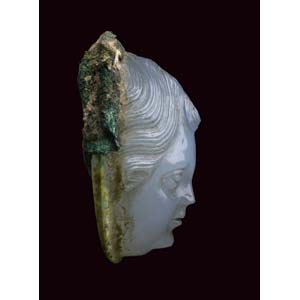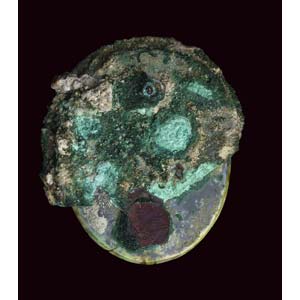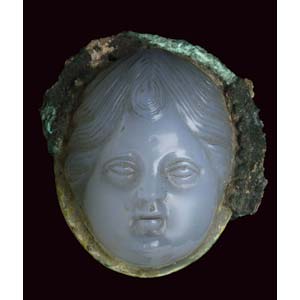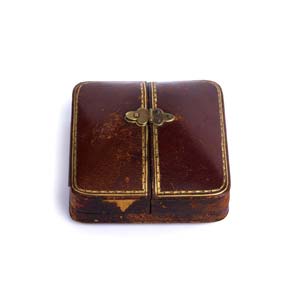
- Home
- Aste in corso
-
Aste passate
- Numismatica
- Filatelia
- Archeologia
- Pittura e Scultura antica
- Gioielli, Argenti, Orologi
- Glittica Antica e Moderna
- Ceramiche e Porcellane antiche
- Antiquariato
- Arte Moderna e Contemporanea
- Arti decorative e Design del XX secolo
- Stampe e Multipli d'autore
- Arte Asiatica e Tribale
- Fotografia
- Arte Medievale
- Cornici Antiche
- Fashion, Textiles & Luxury
- Libri, Autografi e Memorabilia
- Vini e distillati
- Oddities, Curiosities & Wonders
- Info
- Asta Live
Lotto 325 - Asta 43
Descrizione
Extraordinary and rare phalera of Imperial Roman Age, in precious chalcedony. Portrait of Eros.
Extraordinary Roman Imperial phalera in remarkable bluish chalcedony with bright shades. The specimen, of an oval shape, depicts Eros’ face, the which is characterized by his typical plumpy cheeks and the small, semi-closed mouth. The pupils show the iris, which is carved towards the upper part; the hair, delicately engraved with great gentleness and refinement, are harmoniously arranged on the sides and tied by a knot. The artifact is visibly intact; on the edge and back it shows traces of the ancient bronze setting, the which is tenaciously stuck to the stone. The very fine executive and stylistic refinement, not usual for this kind of artifacts, and the choice of the stone quality (the which shows a wonderful polishing) make this item especially valuable. Its dating is set between the 1st and the 2nd century A.D.
Provenance: Ex-Christie's, London, 21st November 1978, lot. 307-plate 54 (“A fine Hellenistic Chalcedony mask of Eros from a breast ornament, carved in cameo, and with part of the bronze or copper surround still adhering to it - 1 ½ x 1 in. circa 3rd Century B.C. -in fitted velvet case”) . A similar specimen, even though of a less refined technique and style, has been sold at Sotheby’s (NY) during the antique auction of the 12th December 2013, lot 54. Phaleras are considered as military decorations to be worn on suits of armour, as testimony of an act of valor. Those decorations were usually made of bronze (and depicting lion protomes, masques of Eros and Gorgons and portrayed busts), and more suitable for battles, even for horse harness. The chalcedony specimens, really more delicate and precious, should rather be related to the situation of triumphal parades, or of award assignments for military values. On roman soldiers they were organized in three rows, and tied with straps made of reinforced leather; they formed a kind of breastplate which was worn and then fastened on the armour. The funeral stela of the highly decorated centurion Marcus Celius, who bravely died with the VIIIth legion in the Teutoburg forest, shows him with all his military decorations on; among these, there were five phaleras on the breast (Landesmuseum, Bonn).
References: M. Feugère “Phalères romaines en calcédoine” in Miscellanea di studi archeologici e di Antichità vol 3, 1989, pp. 31-51; idem vol 2, 1986, pp. 89-132. See also Antonio Giuliano, I cammei dalla Collezione Medicea del Museo Archeologico di Firenze. cameo 39 x 25, mounting mm 42 x 37 x 21
1st and 2nd century A.D.
Utilizzare il modulo di registrazione oppure effettuare il login cliccando sul link login in alto a destra.
Per qualsiasi informazione contattare info@bertolamifineart.com
 Il rispetto della tua riservatezza è la nostra priorità
Il rispetto della tua riservatezza è la nostra priorità
Questo sito fa uso di cookie per migliorare l’esperienza di navigazione degli utenti e per raccogliere informazioni sull’utilizzo del sito stesso. Sono presenti inoltre cookie che possono essere utilizzati per la selezione di annunci e contenuti pubblicitari personalizzati. Puoi consultare la nostra cookie policy, accettare tutti i cookie e proseguire nella navigazione cliccando su "Accetta" oppure personalizzare la tua scelta cliccando su "Personalizza".
Cookie Policy
Cookies
Per far funzionare bene questo sito, a volte installiamo sul tuo dispositivo dei piccoli file di dati che si chiamano "cookies". Anche la maggior parte dei grandi siti fanno lo stesso.
Cosa sono i cookies?
Un cookie è un piccolo file di testo che i siti salvano sul tuo computer o dispositivo mobile mentre li visiti. Grazie ai cookies il sito ricorda le tue azioni e preferenze (per esempio login, lingua, dimensioni dei caratteri e altre impostazioni di visualizzazione) in modo che tu non debba reinserirle quando torni sul sito o navighi da una pagina all'altra.
Come utilizziamo i cookies?
Cookie di terze parti
Google Analytics
Questo sito utilizza Google Analytics per raccogliere informazioni circa l'utilizzo degli utenti del proprio sito web. Google Analytics genera informazioni statistiche e di altro genere attraverso i cookie, memorizzati sui computer degli utenti. Le informazioni generate relative al nostro sito web sono utilizzate per fare dei report sull’utilizzo dei siti web. Google memorizzerà ed utilizzerà queste informazioni. La politica sulla privacy di Google è disponibile al seguente indirizzo: https://policies.google.com/privacy.
Non è necessario abilitare i cookies perché il sito funzioni, ma farlo migliora la navigazione. È possibile cancellare o bloccare i cookies, però in questo caso alcune funzioni del sito potrebbero non funzionare correttamente.
Le informazioni riguardanti i cookies non sono utilizzate per identificare gli utenti e i dati di navigazione restano sempre sotto il nostro controllo. Questi cookies servono esclusivamente per i fini qui descritti.
Come controllare e modificare i cookies?
In qualsiasi momento è possibile modificare o revocare il proprio consenso dalla dichiarazione dei cookie sul nostro sito Web.
Informativa sulla privacy
Scopra di più su chi siamo, come può contattarci e come trattiamo i dati personali nella nostra informativa sulla privacy.
I cookie necessari contribuiscono a rendere fruibile il sito web abilitandone funzionalità di base quali la navigazione sulle pagine e l'accesso alle aree protette del sito. Il sito web non è in grado di funzionare correttamente senza questi cookie.
| Nome | Fornitore | Scopo | Scadenza |
|---|---|---|---|
| cookieConsent | Bid Inside | Memorizza lo stato del consenso ai cookie dell'utente per il dominio corrente | 6 mesi |
| PHPSESSID | Bid Inside | Preserva gli stati dell'utente nelle diverse pagine del sito. | Quando termina la sessione di navigazione |
| f_display | Bid Inside | I cookie f_display memorizzano la modalità di visualizzazione scelta dall'utente nelle pagine in cui sono presenti delle liste | Quando termina la sessione di navigazione |
| f_page | Bid Inside | I cookie f_page memorizzano la pagina visualizzata dall'utente nelle pagine in cui sono presenti delle liste | Quando termina la sessione di navigazione |
| f_rec_page | Bid Inside | I cookie f_rec_page memorizzano il numero di elementi da visualizzare per pagina scelto dall'utente nelle pagine in cui sono presenti delle liste | Quando termina la sessione di navigazione |
| f_order_by | Bid Inside | I cookie f_order_by memorizzano il parametro di ordinamento selezionato dall'utente nelle pagine in cui sono presenti delle liste | Quando termina la sessione di navigazione |
| f_order_dir | Bid Inside | I cookie f_order_dir memorizzano la direzione di ordinamento scelta dall'utente nelle pagine in cui sono presenti delle liste | Quando termina la sessione di navigazione |
| watch_list_show_imgs | Bid Inside | Il cookie watch_list_show_imgs memorizza la scelta dell'utente riguardo il mostrare o il nascondere le immagini dei lotti nella pagina con la lista dei lotti in osservazione | Quando termina la sessione di navigazione |
| selected_voice | Bid Inside | Il cookie selected_voice memorizza la voce selezionata dall'utente per la sintesi vocale presente nell'asta live | 1 Mese |
| include_autobids | Bid Inside | Il cookie include_autobids memorizza la scelta dell'utente di mostrare o nascondere le proprie auto-bid nella pagina 'Le tue offerte' | 6 mesi |
I cookie analitici aiutano a capire come i visitatori interagiscono con il sito web, raccogliendo e trasmettendo informazioni statistiche al Titolare del trattamento.
| Nome | Fornitore | Scopo | Scadenza |
|---|---|---|---|
| _ga | Registra un ID univoco utilizzato per generare dati statistici su come il visitatore utilizza il sito internet. | 2 anni | |
| _gat_gtag | Utilizzato da Google Analytics per limitare la frequenza delle richieste | 1 giorno | |
| _gat | Utilizzato da Google Analytics per limitare la frequenza delle richieste | 1 giorno | |
| _gid | Registra un ID univoco utilizzato per generare dati statistici su come il visitatore utilizza il sito internet. | 1 giorno | |
| __utma | Bid Inside | Utilizzato per distinguere utenti e sessioni. Il cookie viene creato quando viene eseguita la libreria javascript e non esistono cookie __utma esistenti. Il cookie viene aggiornato ogni volta che i dati vengono inviati a Google Analytics. | 2 anni |
| __utmt | Bid Inside | Utilizzato per limitare la velocità di richiesta. | 10 minuti |
| __utmb | Bid Inside | Utilizzato per determinare nuove sessioni/visite. Il cookie viene creato quando viene eseguita la libreria javascript e non esistono cookie __utmb esistenti. Il cookie viene aggiornato ogni volta che i dati vengono inviati a Google Analytics. | 30 minuti |
| __utmc | Bid Inside | Non utilizzato in ga.js. Impostato per l'interoperabilità con urchin.js. Storicamente, questo cookie operava insieme al cookie __utmb per determinare se l'utente si trovava in una nuova sessione/visita. | Quando termina la sessione di navigazione |
| __utmz | Bid Inside | Memorizza la sorgente di traffico o la campagna che spiega come l'utente ha raggiunto il tuo sito. Il cookie viene creato quando viene eseguita la libreria javascript e viene aggiornato ogni volta che i dati vengono inviati a Google Analytics. | 6 mesi |
| __utmv | Bid Inside | Utilizzato per memorizzare dati variabili personalizzati a livello di visitatore. Questo cookie viene creato quando uno sviluppatore utilizza il metodo _setCustomVar con una variabile personalizzata a livello di visitatore. Questo cookie è stato utilizzato anche per il metodo _setVar deprecato. Il cookie viene aggiornato ogni volta che i dati vengono inviati a Google Analytics. | 2 anni |
I cookie di preferenza/tecnici consentono a un sito web di ricordare le informazioni che influenzano il modo in cui il sito si comporta o si presenta, come la lingua preferita o la regione che ti trovi.
Non usiamo cookie di questo tipo.I cookie di profilazione vengono utilizzati per finalità di marketing, per monitorare i visitatori del sito web. L'intento è quello di visualizzare annunci pertinenti e coinvolgenti per il singolo utente.
| Nome | Fornitore | Scopo | Scadenza |
|---|---|---|---|
| _fbp | Facebook Pixel, cookie di targeting e pubblicitario. Questo cookie consente di mostrare la nostra pubblicità alle persone che hanno già visitato il nostro sito Web, quando sono su Facebook o su una piattaforma digitale supportata da Facebook Advertising. | 6 mesi | |
I cookie non classificati sono i cookie che sono in fase di classificazione, insieme ai fornitori di cookie individuali.
Non usiamo cookie di questo tipo.










 326
326